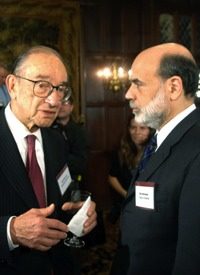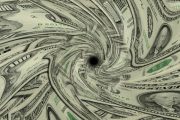
An article in the New York Times asked that since the Federal Reserve “failed to recognize the last bubble,… why should Congress, or anyone else, have faith that future Fed officials will recognize the next [one]?”
The roots of the present Great Recession stretch back to the bursting of the last bubble — the tech bubble — in the late 1990s. As the stock market declined sharply, the Fed under then-chairman Alan Greenspan lowered interest rates in an attempt to keep the economy from collapsing. The Times succinctly noted in its overview of the credit crisis that "lower interest rates make mortgage payments cheaper, and demand for homes began to rise, sending prices up. In addition, millions of homeowners took advantage of the rate drop to refinance their existing mortgages. As the industry ramped up, the quality of the mortgages went down."
The early warning signals were noted in 2005, and by 2006, delinquencies and defaults began to rise as homeowners found it increasingly difficult to sell their homes or refinance their mortgages.
In June 2007, two hedge funds that had invested heavily in subprime mortgages collapsed. As the year went on, foreclosures put pressure on housing prices, and even prime mortgage holders began to get in trouble. The economy officially went into recession in November.
Where were Mssrs. Bernanke and Greenspan while all of this was going on?
Prior to being nominated to replace Alan Greenspan when his term ran out in 2006, Bernanke was chairman of President Bush’s Council of Economic Advisors. During hearings for his nomination, Bernanke pointed out that housing prices had risen by nearly 25 percent over the prior two years, saying these increases “largely reflect strong economic fundamentals” in jobs, incomes, and the formation of new households.
When it was pointed out that housing prices were rising too fast and were likely forming a bubble that could collapse and trigger an economic downturn, Bernanke responded, “House prices are unlikely to continue rising at current rates, [but] a moderate cooling in the housing market, should one occur, would not [inhibit] the economy [from] continuing to grow at or near its potential.”
Greenspan concurred. As far back as April 2002, at a Joint Economic Committee meeting, he said, “The ongoing strength in the housing market has raised concerns about the possibly emergence of a bubble in home prices…. Even if a bubble were to develop in a local market, it would not necessarily have implications for the nation as a whole.”
In June 2004, Senator Evan Bayh (D-Ind.) noted that housing prices had outstripped the growth in incomes over the past several years, and asked, “Are you [Greenspan] concerned about housing prices at this point?" Greenspan responded, “Prices have been moving up faster than they have been…. There’s been a faster pace today, but not enough in our judgment to raise major concerns…. Our forecast is generally flat…. Where house prices go, I’m not sure, but I would be quite surprised if they showed continued acceleration on the up side.”
In October 2004, Greenspan said that “measures of household financial stress do not, at least to date, appear overly worrisome.” He went on to say, “Many of those who purchased their residence more than a year ago have equity buffers in their homes adequate to withstand any price decline other than a very deep one.”
In March 2005, Greenspan addressed the Council on Foreign Relations and noted that “a number of analysts have conjectured that the extended period of low interest rates is spawning a bubble in housing prices in the United States which will, at some point, implode. Their concern is that, if this were to occur, highly leveraged homeowners would be forced to sharply curtail their spending. To be sure, indexes of house prices based on repeat sales of existing homes have significantly outstripped increases in rents, suggesting at least the possibility of price misalignment in some housing markets.” He added:
But a destabilizing contraction in nationwide house prices does not seem the most probable outcome. To be sure, the recent marked increase in the investor share of home purchases suggests rising speculation in homes. [Owner occupants are rarely home speculators because to sell, they must move.] However, nominal house prices in the aggregate have rarely fallen and certainly not by very much. And even should more-than-average price weakness occur, the increase in home equity as a consequence of the recent sharp rise in prices should buffer the vast majority of homeowners.
Bernanke remained blind to the obvious as well. At a House of Representatives hearing in February 2006, he said, “The housing market has been very strong for the past few years. Housing prices have been up quite a bit. Residential investment has been very strong.” He continued, “There are some straws in the wind that housing markets are cooling a bit [but] the decline in activity … will be moderate. So we expect the housing market to cool but not to change very sharply.”
In that same month, Bernanke drafted the Economic Report of the President which said, “The economy has shifted from recovery to sustained expansion…. The U.S. economy continues to be well positioned for long term growth.”
In April 2006, Bernanke said, “The available data on the housing market … suggests that this sector will most likely experience a gradual cooling rather than a sharp slowdown.”
In July 2006, Representative Gary Miller (R–Calif.) took Bernanke to task: “You’ve also indicated that there’s been a gradual cooling in the housing market. And I think that might be an understatement.” Bernanke demurred, responding that “housing prices have risen at double-digit rates for about five years … and that obviously can’t go on forever.”
Later that month, at another hearing, Bernanke continued his denials that anything was amiss: “Sales [of homes] should ultimately be supported by growth in income and employment as well as by mortgage rates that … remain fairly low. The declines in residential construction will likely continue … although the magnitude of the drag on growth should diminish over time.”
By February 2007, the economy was clearly in trouble. But Bernanke remained in denial: “Overall economic prospects for households remains good. The labor market is expected to stay healthy. And real incomes should continue to rise. The business sector remains in excellent financial condition.”
In July 2007, Bernanke was doggedly defending his outlook: “Employment should continue to expand. The global economy continues to be strong…. Financial markets have remained supportive of economic growth.”
The recession was officially recognized as starting in November 2007, but in February 2008, Bernanke continued his economic platitudes: “The nonfinancial business sector remains in good financial condition with strong profits, liquid balance sheets, and corporate leverage near historic lows. [We are anticipating a] moderation of the contraction in housing and the strains in financial and credit markets.”
By June 2008, Bernanke finally acknowledged the collapsing economy, but said that “the risk that the economy has entered a substantial downturn appears to have diminished over the past month or so.”
In May 2009, Bernanke continued to deny reality: “Currently, we don’t think [the unemployment rate] will get to 10 percent.”
Even a strong supporter of Bernanke’s reappointment as head of the Fed, Keynesian economist Paul Krugman, admitted that “he failed to see this coming and he was behind the curve.”
The Wall Street Journal has questioned the wisdom of appointing Bernanke to another term, based upon his record over the last four years. The Journal points out, according to the Federal Open Market Committee transcripts dating back to 2003, “that Mr. Bernanke was the intellectual architect of the decision to keep monetary policy exceptionally easy for far too long [and] ignored the asset bubbles in commodities and housing, dismissed concerns about dollar weakness, and in the process stoked the credit mania that led to the financial panic.”
Gary North, on his members’ only website, says,
Deception has always worked to the FED’s advantage. It remained politically untouchable until Ron Paul got over 300 House members to co-sponsor a bill to audit the FED. At the heart of all central banking is deception. The central bank bails out the largest banks when their deception threatens their survival.
Once Congress is able to audit the Fed, the duplicity and deception will be exposed to the light of day. That will build pressure to abolish the Fed once and for all and restore the constitutional mandates about coin and currency to their rightful place.
Photo of Greenspan (left) and Bernanke: AP Images



